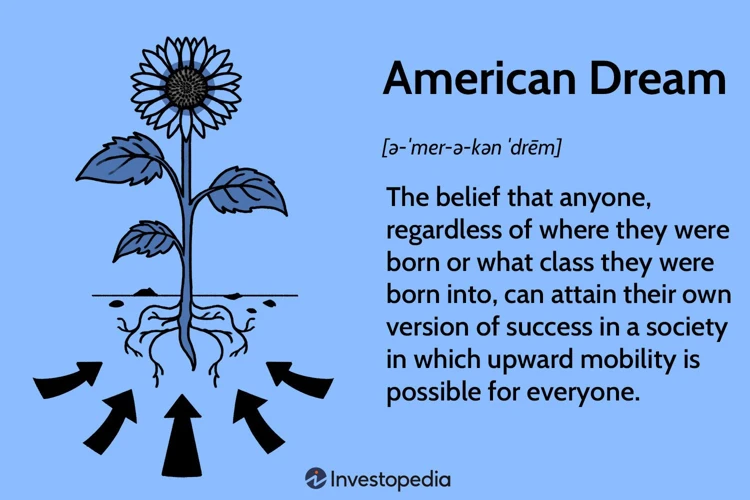The American Dream, a concept deeply ingrained in the fabric of American society, has captured the imagination of people around the world for centuries. It represents the idea that through hard work, determination, and equal opportunity, anyone can achieve prosperity, success, and upward mobility. However, as we delve into the statistics behind the American Dream, a comprehensive analysis unravels a complex and often perplexing reality. In this article, we will explore the various dimensions of the American Dream, the measurements used to gauge its attainment, the factors that influence its realization, the challenges and barriers individuals face in achieving it, and glimpses of success stories that inspire us. Join us on this journey as we aim to shed light on the current state of the American Dream and what the future may hold.
The Concept of the American Dream

The concept of the American Dream embodies the belief that every individual has the opportunity for success and upward mobility through hard work and equal access to resources. It is a vision that has evolved and adapted throughout history, reflecting the changing aspirations and values of society. The American Dream encompasses various ideals, including economic prosperity, homeownership, education, and freedom. It represents the pursuit of happiness, personal fulfillment, and the ability to create a better future for oneself and one’s family. While the American Dream is deeply ingrained in American culture, its interpretation and realization can differ among individuals and communities. It is a concept that sparks hope, inspires ambition, and raises questions about the realities and challenges of achieving such ideals in an ever-changing world.
Defining the American Dream
Defining the American Dream is no simple task, as the concept itself is multifaceted and subjective. While there is no universally agreed-upon definition, the American Dream generally encompasses the ideals of individual freedom, economic opportunity, and upward social mobility. For some, it may revolve around achieving financial success and material wealth. For others, it may focus on personal fulfillment, pursuing one’s passions, or contributing to society. The American Dream can also be influenced by cultural, racial, and generational factors, shaping how individuals perceive and pursue their aspirations. Despite its elusive nature, the American Dream remains a powerful and enduring symbol of hope, inspiring countless individuals to strive for a better future.
The Historical Context
The historical context of the American Dream provides valuable insights into its origins and evolution. The concept traces back to the early European settlements in America, where the promise of freedom and opportunity attracted thousands seeking a better life. Over time, the American Dream became interwoven with the ideals of equality, democracy, and individualism, especially during the founding of the United States. Its significance grew during periods of rapid industrialization, such as the late 19th and early 20th centuries, as millions flocked to cities in pursuit of economic prosperity. The American Dream also took on different meanings during times of economic crisis, such as the Great Depression, when dreams of stability and security were shattered. The historical context reveals a complex tapestry of dreams, aspirations, challenges, and societal transformations that continue to shape the American Dream today.
Measuring the American Dream

Measuring the American Dream requires a comprehensive analysis of various economic and social indicators. Economic indicators such as GDP per capita, average income levels, and employment rates provide insights into economic well-being and opportunities for upward mobility. Social indicators, on the other hand, encompass factors such as education rates, healthcare access, homeownership rates, and social mobility. These indicators help gauge the extent to which individuals are able to achieve their aspirations and improve their quality of life. Racial and gender disparities play a significant role in the measurement of the American Dream, highlighting the unequal distribution of resources and opportunities. By examining these indicators, we can gain a deeper understanding of the current state of the American Dream and identify areas where progress is needed in order to promote equal opportunities and enhance social mobility.
Economic Indicators
Economic indicators play a crucial role in measuring the progress and attainment of the American Dream. These indicators provide valuable insights into the economic well-being of individuals and households. Key economic indicators include measures such as gross domestic product (GDP), income distribution, employment rate, poverty rate, and wealth accumulation. They help gauge the extent of economic opportunity, income inequality, and social mobility within society. These indicators allow us to assess the accessibility of resources, the quality of jobs, and the overall economic health of the nation. By analyzing economic indicators, we can better understand the economic landscape and the potential barriers or opportunities that exist for individuals striving to achieve their version of the American Dream.
Social Indicators
Social indicators serve as key metrics in measuring the progress and well-being of individuals and communities in relation to the American Dream. These indicators provide insights into aspects such as education, healthcare, social mobility, and family dynamics. By analyzing indicators such as educational attainment, access to healthcare, income distribution, and poverty rates, policymakers and researchers gain a better understanding of social equity and the barriers individuals may face in achieving their version of the American Dream. These indicators reveal the disparities that exist within society, highlighting areas where improvements are needed to ensure equal opportunities for all. They provide valuable insights into the social fabric of our communities and prompt discussions on how to address systemic issues and promote upward mobility for every individual.
Racial and Gender Disparities
Racial and gender disparities play a significant role in shaping the extent to which individuals can achieve the American Dream. Despite the ideal of equal opportunity, marginalized communities face systemic barriers that hinder their progress and limit their access to resources. Historical injustices and ongoing discrimination have resulted in unequal outcomes in areas such as education, employment, and wealth accumulation. For example, Black Americans and other racial minorities often experience lower wages, higher unemployment rates, and limited access to quality education and affordable housing. Similarly, gender disparities persist, with women facing challenges such as the gender wage gap and limited representation in top leadership positions. These disparities not only hinder individual progress but also perpetuate broader inequality within society. Addressing these disparities and promoting inclusivity is crucial for achieving a more equitable American Dream for all individuals, regardless of their race or gender.
Factors Influencing the American Dream

Factors Influencing the American Dream can be diverse and multifaceted. Among the key influencers are educational attainment, income inequality, and geographical location. Educational attainment plays a crucial role, as higher levels of education are often associated with greater economic opportunities and social mobility. Access to quality education, vocational training, and opportunities for lifelong learning are vital in realizing the American Dream. Income inequality also affects the ability to achieve the American Dream, as disparities in wealth and income distribution can limit upward mobility and hinder economic progress for certain individuals and communities. Geographical location, another significant factor, can impact access to resources, job opportunities, and social services, creating disparities in opportunity and quality of life across different regions. Understanding and addressing these factors can help create an environment that fosters equal opportunities and enhances the chances of achieving the American Dream for all individuals and communities.
Educational Attainment
Educational attainment plays a crucial role in shaping an individual’s ability to achieve the American Dream. A strong educational foundation not only enhances job prospects but also fosters personal development and critical thinking skills. Higher levels of education are often associated with higher income levels and increased opportunities for upward mobility. According to education statistics, individuals with college degrees tend to earn more and have lower unemployment rates compared to those with lower levels of education. However, educational attainment is not equally accessible to all. Socioeconomic disparities, limited resources, and systemic inequalities can create barriers to educational opportunities, perpetuating a cycle of inequality. To bridge this gap, initiatives aimed at improving access to quality education, providing support to disadvantaged students, and enhancing educational equity are essential in ensuring that the American Dream remains attainable for everyone, regardless of their background.
Income Inequality
Income inequality is a significant factor influencing the achievement of the American Dream. It refers to the unequal distribution of income among individuals or households in a society. High levels of income inequality can hinder social mobility and create barriers to fulfilling the aspirations of the American Dream. When a significant portion of the population faces financial hardships and limited access to resources, it becomes more challenging for them to improve their economic status and achieve upward mobility. Income inequality can affect various aspects of life, including education, healthcare, and opportunities for economic advancement. The existence of a substantial wealth gap can perpetuate systemic disadvantages for certain groups and contribute to social and economic divisions within society. Addressing income inequality is crucial for creating a more equitable society and increasing opportunities for individuals to pursue their American Dream.
Geographical Location
Geographical location plays a significant role in shaping an individual’s opportunities and prospects for achieving the American Dream. Regional disparities in economic development, access to quality education, and job opportunities can greatly impact an individual’s chances of upward mobility. For example, metropolitan areas often offer a wider range of job prospects and higher wages compared to rural areas. Similarly, the cost of living and housing affordability can vary drastically depending on the location. Certain areas may have better social infrastructure, such as healthcare facilities and community resources, which can contribute to a higher quality of life. All these factors emphasize the importance of considering the geographical context when analyzing the pursuit of the American Dream.
Challenges and Barriers to Achieving the American Dream

Challenges and barriers pose significant hurdles to achieving the American Dream for many individuals. Generational issues can create obstacles, as economic disparities and social inequities can be perpetuated across families and communities. Systemic inequalities, such as discrimination based on race, gender, or socioeconomic status, create additional challenges, limiting access to opportunities and resources. Social mobility constraints affect individuals’ ability to move up the socioeconomic ladder, with limited access to quality education, healthcare, and affordable housing. These barriers can create a cycle of disadvantage, making it difficult for individuals to escape poverty or improve their circumstances. Overcoming these challenges requires addressing structural inequalities, advocating for inclusive policies, and promoting equal access to education, employment, and social support systems. By dismantling these barriers, society can take steps towards a more equitable landscape where the American Dream becomes achievable for all.
Generational Issues
Generational issues play a significant role in shaping the American Dream. Each generation faces unique challenges and opportunities that can impact their ability to achieve upward mobility and success. One of the key generational issues is the increasing burden of student loan debt, which hampers the financial stability and progress of younger generations. The rising cost of education has led to a substantial increase in student loan debt, making it harder for individuals to save for a home, start a family, or invest in their future. Additionally, changing job markets and technological advancements have also created disparities between generations, affecting employment prospects and income potential. Ensuring equal opportunities and addressing these generational issues is crucial for safeguarding the American Dream and promoting social and economic mobility for all.
Systemic Inequalities
Systemic inequalities play a significant role in shaping the pursuit of the American Dream. These inequalities stem from long-standing and deeply ingrained social, economic, and political structures that create disadvantages for certain groups of people. Factors such as race, gender, and socioeconomic status can heavily influence access to resources, opportunities, and societal support. For example, studies have shown that minority groups face higher poverty rates, limited access to quality education, and discrimination in employment opportunities. Additionally, disparities in healthcare, criminal justice, and wealth distribution further contribute to the perpetuation of systemic inequalities. Addressing these systemic issues requires a multifaceted approach, including policy reforms, increased awareness, and efforts towards creating an inclusive and equitable society. It is crucial to recognize and challenge these systemic barriers in order to provide equal opportunities for all individuals in their pursuit of the American Dream.
Social Mobility Constraints
Social mobility constraints pose significant challenges to individuals striving to achieve the American Dream. These constraints can be influenced by various factors, such as socioeconomic status, educational opportunities, and systemic inequalities. The ability to move up the social ladder and improve one’s economic standing is not always accessible to everyone. Studies have shown that individuals born into lower-income households often face barriers that limit their upward mobility. These barriers include inadequate access to quality education, limited job opportunities, and discriminatory practices. Additionally, systemic inequalities, such as racial and gender disparities, can further hinder social mobility. It is crucial to address these constraints in order to create a society where everyone has an equal chance of realizing their American Dream.
Case Studies and Success Stories

Case studies and success stories provide valuable insights into the realities and possibilities of achieving the American Dream. They offer a glimpse into the lives of individuals who have overcome challenges, seized opportunities, and realized their ambitions. These stories highlight the diverse paths people have taken to achieve their version of success and serve as a source of inspiration for others. From entrepreneurs who have built multimillion-dollar businesses to students who have defied the odds to pursue higher education, each case study showcases the resilience, determination, and adaptability required to turn dreams into reality. These stories demonstrate that the American Dream is not just an abstract concept, but a tangible goal that can be attained through hard work, perseverance, and a little bit of luck. Through these examples, individuals can find encouragement and motivation to pursue their own dreams, regardless of the obstacles they may encounter along the way.
The Future of the American Dream
The future of the American Dream is a topic of ongoing debate and speculation. As society continues to evolve, so too do the opportunities and challenges for individuals striving to achieve their version of the American Dream. Several factors shape the outlook for the future. Economic trends, such as income inequality and technological advancements, will influence the distribution of wealth and access to resources. Demographic shifts, including changing racial and ethnic compositions, will impact social dynamics and perceptions of opportunity. Environmental considerations and the urgency to address climate change will shape the sustainability and livability of communities. Additionally, social and political movements advocating for equality, justice, and systemic change will play a significant role in shaping the future landscape of the American Dream. It is essential for society to engage in constructive dialogue and take collective action to ensure that the American Dream remains accessible and inclusive for all individuals, regardless of their backgrounds and circumstances.
Possible Solutions
Possible solutions to address the challenges and barriers faced in achieving the American Dream require a multifaceted approach. One crucial aspect is the need for equal access to quality education and skill development programs. Investing in educational opportunities that prioritize underserved communities and offer resources for career advancement can help bridge the gap and provide individuals with the tools they need to succeed. Additionally, addressing systemic inequalities by implementing policies and initiatives that promote equal opportunities in employment, housing, and healthcare is vital. This includes efforts to combat discrimination, improve social mobility, and ensure fair treatment for all individuals. By creating an environment that fosters inclusivity, diversity, and equal access to resources, we can work towards a society where the American Dream becomes attainable for all.
Conclusion
In conclusion, the American Dream remains a compelling and elusive concept in today’s society. Our comprehensive analysis has shed light on the various dimensions, challenges, and factors surrounding the pursuit of the American Dream. While economic and social indicators provide insights into the state of opportunity and upward mobility, there are persistent disparities, including racial and gender inequalities, that hinder its attainment. Educational attainment, income inequality, and geographical location also play significant roles in shaping the possibilities for achieving the American Dream. Overcoming generational issues, systemic inequalities, and social mobility constraints is crucial in creating a more inclusive and accessible path to success. However, amidst these barriers, there are still success stories that serve as beacons of hope. It is imperative for society to continue working towards solutions that address the complexities of the American Dream and ensure equal opportunities for all individuals. This ongoing pursuit of the American Dream will shape the future of our nation and define our collective aspirations.
Frequently Asked Questions
What is the origin of the American Dream?
The concept of the American Dream originated from the early settlers who came to America seeking religious freedom and economic opportunities. It became more widely popularized during the 19th and 20th centuries, with the belief that hard work and determination could lead to success and prosperity.
Is the American Dream attainable for everyone?
While the American Dream represents equal opportunities, the reality is that not everyone has an equal chance of achieving it. Factors such as socioeconomic status, race/ethnicity, and access to resources can significantly impact one’s ability to attain the American Dream.
What are some key symbols of the American Dream?
Key symbols of the American Dream include homeownership, a good education, career success, upward economic mobility, and the ability to provide a better life for future generations.
Has the American Dream changed over time?
Yes, the American Dream has evolved over time to reflect changing societal values and aspirations. While early interpretations focused on individual success and economic prosperity, modern interpretations often emphasize factors such as work-life balance, personal fulfillment, and social mobility.
Are there regional differences in the attainment of the American Dream?
Yes, regional differences play a significant role in the attainment of the American Dream. Factors such as economic opportunities, cost of living, and availability of resources can vary across different regions, leading to disparities in achieving the American Dream.
Does education play a crucial role in achieving the American Dream?
Educational attainment is often seen as a critical factor in achieving the American Dream. Higher levels of education can lead to better job prospects, higher incomes, and increased social mobility.
Do racial and gender disparities affect the attainment of the American Dream?
Yes, racial and gender disparities have a significant impact on the attainment of the American Dream. Minority groups and women often face systemic barriers and discrimination that hinder their ability to achieve equal opportunities and reach their full potential.
What role does income inequality play in the American Dream?
Income inequality can pose significant challenges to achieving the American Dream. When wealth and resources are concentrated in the hands of a few, it becomes harder for individuals from lower-income backgrounds to access the opportunities needed to fulfill their dreams.
Are generational issues a barrier to achieving the American Dream?
Generational issues can be a barrier to achieving the American Dream. Economic downturns, rising costs of living, and changes in the job market can make it more challenging for younger generations to achieve the same level of success and prosperity as their parents or older generations.
What are some possible solutions to enhancing the American Dream?
Possible solutions to enhancing the American Dream include reducing income inequality, improving access to quality education, promoting equal opportunities regardless of race or gender, and addressing systemic barriers that prevent individuals from realizing their full potential.







